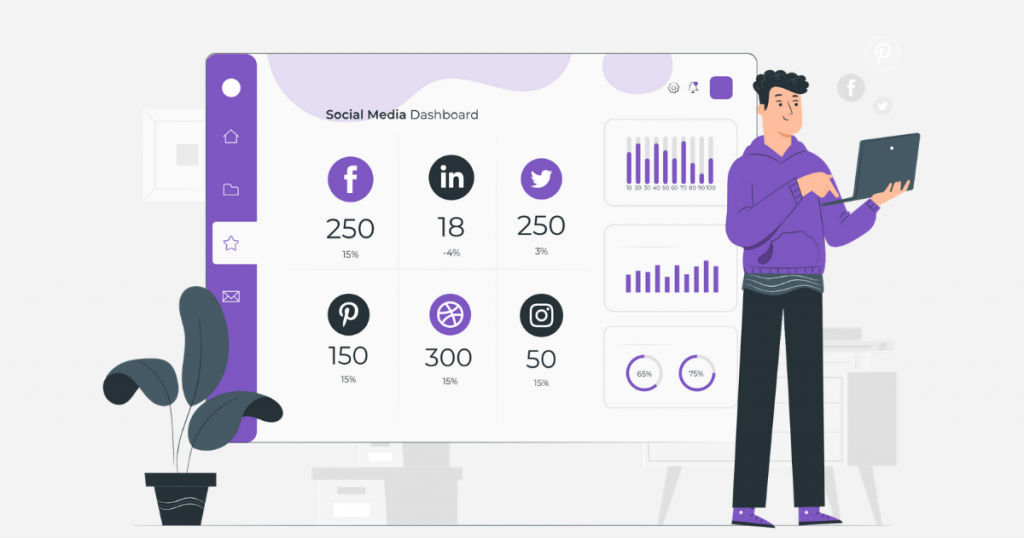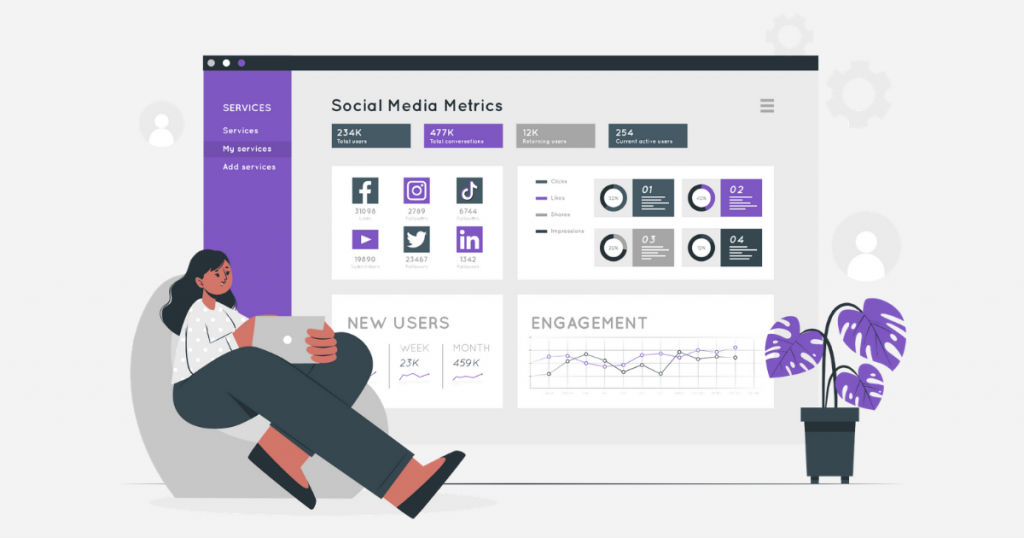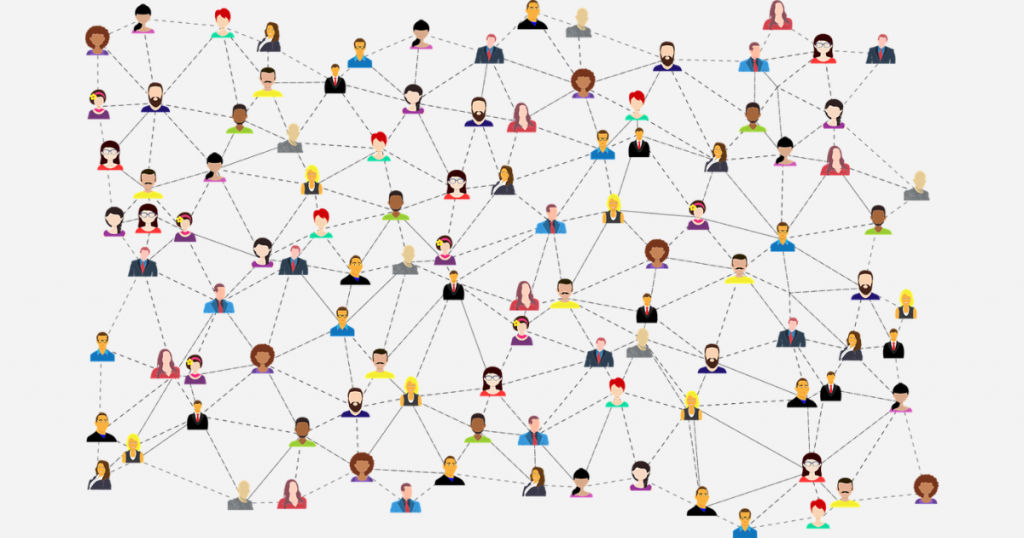
The key to effective digital marketing is social media. Any business plan must include social media in order to be successful. Social media platforms like Instagram, Facebook, LinkedIn, and Twitter have the potential to reach billions of customers. They can give your business a platform to voice its content and the general public to discuss your business.
However, using social media may be a two-edged sword. The consequences might range from explosive business growth to image-damaging controversies. Social media monitoring allows you to get the most out of social media – or, at the absolute least, allows your business to respond to customers. Let us learn more about social media monitoring below.
Table of Contents
What is social media monitoring?
Many businesses may believe that social media monitoring consists solely of watching mentions and responding when asked. Nothing could be further from the truth.
Social media monitoring is the use of tools to listen in on millions of online conversations to analyze public opinion about a specific business, subject, person, or product, and to identify opportunities. In layman’s terms, social media monitoring is the process of monitoring opinions about a business, person, or product via various social and internet channels.
Social media monitoring encompasses the whole internet, including forums, blogs, news sites, and communities where interactions occur on the internet. Social media monitoring can be passive, such as listening to people to learn what they are interested in. It can also be active, such as searching for references to your business, initiatives, or actions.
It entails keeping an eye continuously on the social media activity of contenders, consumers, target audience, and influencers related to the business. It is used particularly by businesses seeking consumer insight to understand current business trends by collecting and processing data.
How do social media monitoring tools work?
Social media monitoring is an algorithm-based program. It crawls and continually indexes sites, similar to how search engines send crawlers to the distant corners of the internet. After indexing a site, you can search it using queries or strings. You can search the indexed sites for mentions, opinions, and feelings about certain goods, brands, businesses, individuals, places, etc.
Social media monitoring tools crawl forums, blogs, review sites, news sites, and the major social media platforms. Certain social media platforms have tight regulations that make it hard for the tools to cover all of their material.
The majority of the social media monitoring tools are specialized data mining software and web crawlers. Big businesses use these tools to search for certain keywords across several websites and blogs. It converts the necessary words and phrases from unstructured to structured database data for analysis using conventional data mining techniques.
Users on social media express themselves with their own language involving various slangs, acronyms, abbreviations, jargon, etc. In order to comprehend what they are saying, you must grasp all their ways of communication which is not possible. Tools that employ cognitive computing technology can interpret intention, feeling, perspective, and choices expressed by people on social media.
What makes social media monitoring so essential?

Customers want to know that their opinions are heard by the businesses to which they are directed via social media. It is relevant for others to actively participate in changing or improving the services and goods they purchase. It helps your customers feel recognized and appreciated.
Companies can uncover new possibilities or get valuable feedback and information about rivals by listening to discussions on social media and the web.
An effective social media monitoring plan will allow you to consolidate all of your brand’s mentions and search parameters into one location. Thereby, it allows you to spend your time reacting to crucial messages and building a strategy based on your findings.
This makes social media monitoring essential for any business. Your curiosity is the only limit to what you can learn through social media monitoring.
Advantages of using social media monitoring
Social media monitoring can provide you with real-time insight into what people are saying about your business. It is done by gathering publicly accessible data and arranging it in a way that works for you.
Social media monitoring can also assist you in increasing internet visibility for your e-commerce business. You can respond to what people are saying about your business and use the same social media platform to interact with potential customers.
It can result in quicker reaction times, the avoidance of public relations crises, and the identification of brand advocates. It also assists you in keeping track of brand advocates with whom you would want to engage. Social media monitoring also aids in filtering out spam and allowing just the relevant information to pass through.
Once you have determined the public opinion of your business using social media monitoring, you can:
- Respond to customers on social media in real-time
- Increase brand trust and originality
- Determine which social media marketing initiatives are doing the best and worse
- Use favorable comments in marketing, advertisements, and so on
- Use negative comments to help you fix mistakes in your business
- Utilize sophisticated reporting features to calculate return on investment
- Understand how particular demographics perceive your business
- Reduce marketing budget by removing platforms with the poorest or lowest levels of interaction.

Social media monitoring statistics for you
- 59% of consumers reach out to brands on social media because they had a great experience.
- 47% of consumers reach out to brands on social media because they have a product or service question.
- 40% of consumers reach out to brands on social media because they had a bad experience.
- 31% of consumers reach out to brands on social media because they have a suggestion or idea.
- 29% of consumers reach out to brands on social media because they need help with a product or service.
- 27% of consumers reach out to brands on social media because they depend on a product or service.
- 11% of consumers reach out to brands on social media because they do not see a product or service that they need.
- 10% of consumers reach out to brands on social media because the brand posted about social/political issues.
- 78% of marketers replied to a consumer request within 12 hours using social media monitoring.
- Consumers are 21% more likely to buy from you if you reply to them on social media.
The differences between social media monitoring and social media listening
Listening is impossible without monitoring. While monitoring, you may tag incoming messages, which you can subsequently utilize to produce listening queries and reports.
Social media monitoring is concerned with the past, whereas social listening is concerned with the future. You respond appropriately when you monitor. However, when you engage in listening, you are taking a broad look at brand mentions and industry trends. You can use this in order to influence future marketing decisions in a better way.
Social media monitoring is all about obtaining information and collecting as much data and information as possible. You record what others are saying about you on social media. You assess your progress and keep track of what is going on in the social sphere of your sector.
The social media listening component is more active and strategic. You sift through the data to find useful information. This might be anything from engaging a satisfied consumer to changing your brand positioning approach. Social media listening makes use of the information gathered to strengthen your social media strategy.
How to use social media monitoring effectively?

1. Be up to date with your audience
Be on the lookout for unusual terms that your target audience may use when you compile your list of terms to monitor. Look out for trending hashtags, new abbreviations related to your sector, new ideas, and new competitors.
When combined with your monitoring system, these insights can give a completely new way of thinking about your business.
2. Consider things other than your business
You should also go outside your business to monitor conversations that may provide a clearer picture of your whole industry. It can also provide possibilities to acquire additional data for your social media monitoring strategy.
In this manner, you can stay connected to your whole sector rather than just discussions of your own business.
3. Experiment with different keyword combinations
Do not restrict your monitoring to basic keywords or key phrases. To determine intent in social signals, use keyword combinations.
Try adding the term “recommend” to a keyword related to your product or sector, for example. You will notice that individuals are actively looking for information on items like yours. You will also get to observe how others in the sector react.
4. Do not restrict social media monitoring to just one language
If you operate your business in countries with multiple languages, you should probably check for keywords in various languages. To keep track of worldwide conversations about your business, you can input all of your translations into a single stream.
5. Compare yourself to your competitors
Understanding the statistics of your competitors offers a rather complete view of the status of your sector and where your brand falls. Monitoring your social share of voice is a simple approach to detect changes in your status with your competitors.
Conclusion
Social media monitoring is an integral component of any social customer care plan. As customers increasingly discuss companies online, businesses’ ability to stay in the loop is becoming increasingly important. This can be done only with the help of social media monitoring.
Businesses that listen to their consumers and adapt and develop as a result will be the ones that succeed. We hope that we were able to give you a detailed insight into social media monitoring.
In case you need help searching for any software, visit SaaSworthy.






